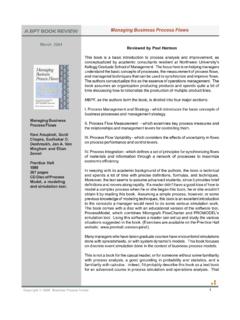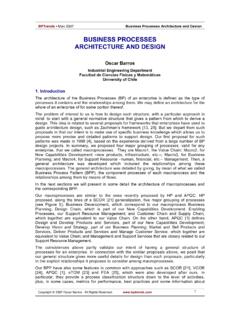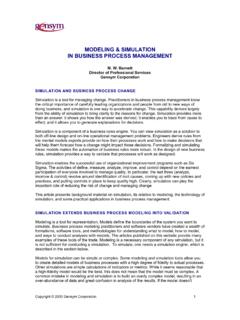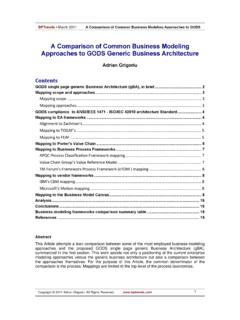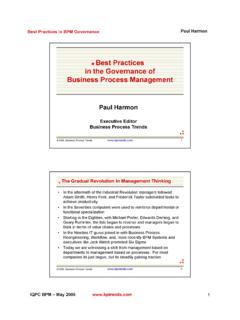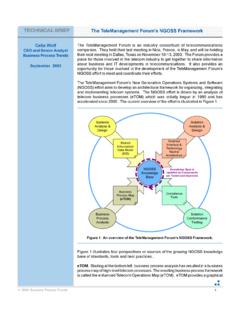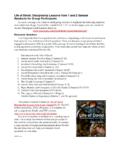Transcription of Value Chains, Value Streams, Value Nets, and Value ...
1 BPTrends April 2009 Value Chains, Value Streams, Value Nets & Value Delivery Chains Copyright 2009 George brown . All Rights Reserved. 1 Value Chains, Value Streams, Value Nets, and Value Delivery Chains George W. brown The Value Chain Group together with partners have developed approaches and methodologies to support the process of successfully aligning business and IT strategies, architecture, design, execution, monitoring, and management of the processes. But there has still been a considerable amount of discussion about Value chains and related concepts like Value streams and Value nets by those involved in business process change.
2 This paper discusses the evolution and current use of these concepts. Clarification of this terminology is especially important to those of us involved in the Value Chain Group, as our framework depends on a clear understanding of these terms. The Value Chain Group The mission of the Value Chain Group is to enable excellence in Value chain performance by leading the development, promotion, and maintenance of a unified, broadly adopted, open standard business process framework and related reference models for Value chain management. The Value Reference Model (VRM) is a key model of the VCG. VRM provides common and normalized business semantics. There are advantages of using VRM as the common business semantics language: There are advantages of using VRM as the common business semantics language: It helps to analyze and understand customer facing BI processes; provides detailed substantiation for any business rules; supports testing the feasibility and potential impact of changes; enables validation of the business rules; and enables extensive support for the collaborations.
3 Figure 1. The VRM Coverage Graphic To identify Value opportunities that will improve the processes, criteria must be established for what should or should not be considered a Value opportunity. Value is to be determined both subjectively (non-quantifiable) and objectively (quantifiable). We must define Value in the context of decisions based on costs/benefits , time, price, quality, innovation and show the decision matrix. Subjective knowledge of Value should be converted into objective knowledge via data and metrics. The recent focus of Value Chain Group research is on Business Agility. Special focus has been given specifically to methods and tools to ensure that business group goals are met in business agility through BPTrends April 2009 Value Chains, Value Streams, Value Nets & Value Delivery Chains Copyright 2009 George brown .
4 All Rights Reserved. 2 Value Chain Management and through the transition to SOA. Value delivery and business flexibility have evolved through concepts of Value Chains, Value Streams, Value Nets, and Value Delivery Chains. Our agenda is to sense operational performance and market change, assuring business agility and driving market distinction by addressing critical areas of need for becoming an Agile Enterprise. Value Chain Analysis or Value Stream Mapping are useful tools for working out how you can create the greatest possible Value for your customers, as well as your best route to profit maximization. Dealing with restructuring Value chains has changed considerably due to the decades of growth in electronic commerce leveraging the internet.
5 This brief document covers some of the conceptual evolution of business process management through concepts of Value Chains, Value Streams, Value Nets, and Value Delivery Chains. Some of the material in this paper comes directly from documents that go back over 20 years, including writing by Michael Porter, James Martin, Ralph Whittle, and David Bovet. The Value chain is a concept from business management that was first described and popularized by Michael Porter in his 1985 best-seller, Competitive Advantage: Creating and Sustaining Superior Performance. [1] Porter termed the larger interconnected system of Value chains the " Value system." [2] A Value system includes the Value chains of a firm's supplier (and their suppliers all the way back), the firm itself, the firm distribution channels, and the firm's buyers (and presumably extends to the buyers of their products, and so on).
6 Figure 2. Porter s Value Chain Value Streams were introduced in Michael Porter s book but were explained more clearly by James Martin in his 1995 book, The Great Transition, which pulls together the many issues, models, and methods for transforming the traditional old-world organization into a Value -creating enterprise. [3] Martin uses Value stream, rather than process, to define the end-to-end stream of activities that deliver particular results for a given customer (external or internal). The 2004 book, Enterprise Business Architecture, by Ralph Whittle and Conrad Myrick, provides a common reference model by defining the business strategy, governance, organization, and business functions, and establishes a baseline that links strategy and results by defining which organizations perform those functions.
7 This book [4] provides a consistent classification of all the tasks, activities, functions, and processes into Value Streams. For the EBA, the Value Streams are the organizing and BPTrends April 2009 Value Chains, Value Streams, Value Nets & Value Delivery Chains Copyright 2009 George brown . All Rights Reserved. 3unifying principle in the foundation. The book represents the initial Enterprise Business Architecture (EBA) for companies and will serve to ensure that investments in information technology support the business of corporations. Figure 3. Whittle & Myrick EBA Navigation David Bovet, a vice president at Mercer Management Consulting, co-authored Value Nets: Breaking the Supply Chain to Unlock Hidden Profits.
8 Inspiration for Value Nets came from the drive to design a new networked paradigm that allows companies to fulfill customer expectations for speed, reliability, convenience, and customization. A Value network is a web of relationships that generates economic Value and other benefits through complex dynamic exchanges between two or more individuals, groups, or organizations. Any organization or group of organizations engaged in both tangible and intangible exchanges can be viewed as a Value network, whether private industry, government, or public sector. [5] Bovet makes it clear that a Value net is a web of relationships that generates economic Value and other benefits through complex dynamic exchanges between two or more individuals, groups, or organizations.
9 BPTrends April 2009 Value Chains, Value Streams, Value Nets & Value Delivery Chains Copyright 2009 George brown . All Rights Reserved. 4 Figure 4. Value Net Scheme - Bovet This brief paper will enable readers to understand how the evolution of these concepts has led to approaches that are now based upon workflow technology, , flow of data and control over cross-organizations. In order to describe the procedure of a restructured Value chain that processes inter-organization transactions, we should use a virtual Value chain model having multiple nodes, such as consumer, merchant, delivery, and manufactory, which are logically hooked on the Internet.
10 Internet workflow technology merged into the electronic commerce will be effective in terms of restructuring market Value chains and reducing costs of processing cross-organizational transactions. Value Chain Value chain is a high-level model of how businesses receive raw materials as input, add Value to the raw materials through various processes, and sell finished products to customers. The Value chain categorizes the generic Value -adding activities of an organization. A Value chain is the disaggregating of a firm into its strategically relevant activities for the purpose of understanding the behavior of costs as well as the existing and potential sources of differentiation. The concept has been extended beyond individual organizations.
